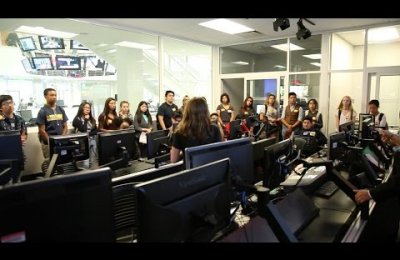Seven graduate students returned from a recent two-week research trip to India full of new knowledge, ideas and life-long memories.
The second-year students in the Master's in Public Diplomacy program – offered in partnership with USC Annenberg and USC Dornsife's School of International Relations – reported their findings as they traveled through New Delhi and Mumbai on the "India: Inside Out" blog. Maya Babla, a Public Diplomacy student who helped organize the trip along with Aparajitha Vadlamannati, compiled the findings for her thesis.
“Over the course of two weeks, we met with Indian government and civil society leaders, explored the culture, and experienced the sights, sounds, and smells of two of India’s largest cities,” Babla wrote in a blog post. “And along the way, we shared our conversations with people from around the world.”
The students' research appraised the role of India's public, private, nonprofit and media actors, as well as how these sectors create the public diplomacy ecosystem in India. They surveyed a wide range of diplomacies — from cultural to economic to citizen-powered initiatives — to understand how each is communicating the idea of India.
Vadlamannati said she found that India has a shortage of workers who specialize in public diplomacy, even though the country has a population of more than 1 billion people.
“At home, in the government, India just doesn’t have the manpower it needs to execute effective public diplomacy,” Vadlamannati wrote. “Running a government, a working democracy, requires manpower composed of steadfast, trustworthy, knowledgeable, and concerned citizens committed to serving their fellow citizen. Unfortunately, entering the civil service is impeded by the constraints of hiring policies, budget restraints, and exams and procedures with limited intake and numerous qualified candidates.”
Student Hend Alhinnawi found that India is creating partnerships between government agencies and civil society, as exemplified by a meeting with writer, social worker and activist Harsh Mander (read post here).
“Mr. Mander’s work is a perfect example of my core learning about development in India: Indians are hands-on when it comes to their own development,” Alhinnawi said. “They are not waiting for the United Nations, or anyone else for that matter, to come in and solve their problems.”
Student Jessica Castillo said that meeting with NGOs and government agencies helped her shed light on the urban issues she came into the trip wanting to explore.
“I wanted to get a sense of what the urban situation really is in India and what improvements are being made,” Castillo said. “So seeing firsthand and speaking to experts in various fields such as e-governance and education was invaluable.”
Castillo said one of her favorite moments of the trip occurred during a weekend visit in Vizag, where the group was hosted by Vadlamannati’s family. Alhinnawi asked Vadlamannati’s grandfather Sivananda Murthy what he thought made a good leader.
“His response was, ‘He has to love his people,’” Castillo said. “For me, that summed up so much of what we saw in many of the people we spoke with in India, and embodies what I believe we should teach and strive for at home.”
The Master's in Public Diplomacy, offered in partnership with USC Annenberg and USC Dornsife's School of International Relations, emphasizes the role of non-state actors, global public opinion, international news and international communication in the public diplomacy process. It is developing the next generation of leadership for international public service, business and nongovernmental organizations.
India: Inside Out blog
Meet the students
Master's in Public Diplomacy






![[web series] Campaign Junkie](https://annenberg.usc.edu/sites/default/files/styles/news_index_featured_small/public/media-youtube/d5gbSRAjFwQ.jpg?itok=YP9_X3fc)


